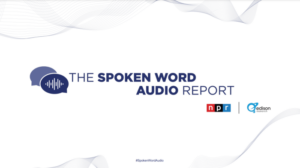
The 2021 edition of the annual Spoken Word Audio Report, a comprehensive survey study fielded by Edison Research with support from NPR, is out. This article describes and illustrates some of the data results. Much more is available (HERE) in the free report and many video interview clips with participants.
This study combines new original survey work (1,000 online interviews with U.S. participants 18 years and older who consume some kind of spoken word audio at least monthly) with the ongoing Share of Ear study that involves over 4,000 survey respondents, 13 years and older in the U.S.
Key findings:
- Spoken Word’s share of audio listening has increased by 40% over the last seven
years; 8% this year - Spoken word audio’s growth is driven by large increases in young and multicultural
audiences - While most listeners cite the ability to multitask one of the main motivations for
spoken word audio listening, young and multicultural audiences are more likely to cite
other reasons such as connection, education, new perspectives, self-improvement
With so much focus on podcasting, it might seem that this study is about podcasting, but spoken word audio also includes audio books and non-digital listening such as radio news, and sports delivered by any platform. The big audio category excluded from the study, whose metrics can be compared to this study’s results, is music listening.
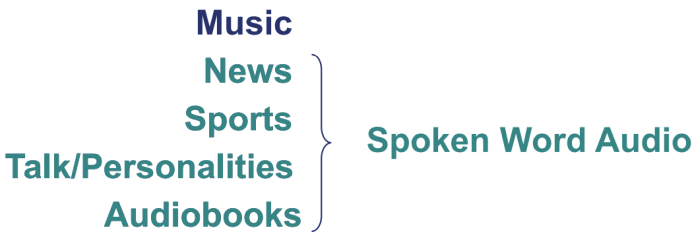
The broadest result to emerge from this study is that 75% of the U.S. population listened to spoken word audio. In that figure, 45% of the U.S population listens to spoken word every day. That’s up from 43% last year. A more dramatic comparison is made to the population percentage seven years ago:
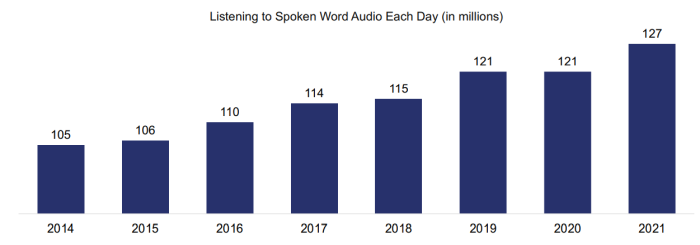
22-million more people listen to spoken word audio in 2021 compared to seven years ago.
It makes sense that the growth of spoken word audio might cause a drop in music listening, and a correlation is indeed fascinatingly clear:
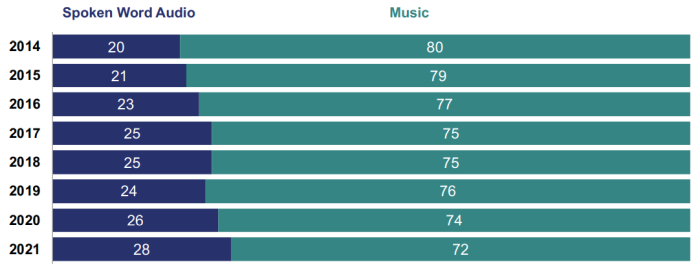
Then there is the question of how spoken word listening gains are represented as a share of time within all listening. Edison Research declares something remarkable — that spoken word TSL (time spent listening) has increased by 40% over seven years, and 8% in the last year.
All age groups participate in the growth of spoken word listening over seven years, although the 55+ cohort has picked up that trend only by 8%. Meanwhile, the 13-34 population group has shifted its listening by an eye-popping 116%. Multicultural listeners are also a driving factor.
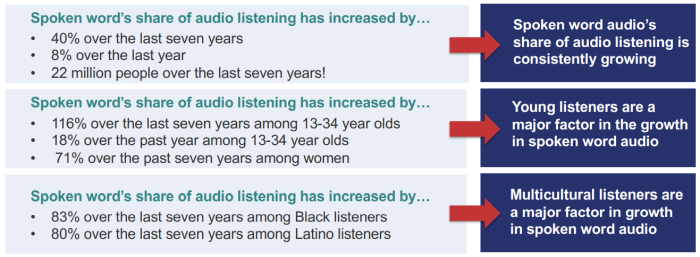
While most listeners cite the ability to multitask one of the main motivations for spoken word audio listening, young and multicultural audiences are more likely to cite other reasons such as connection, education, new perspectives, self-improvement.
Unsurprisingly, podcasting is specifically called out in the study. Fifty-seven percent of the U.S. (13+) population listens to podcasts monthly. And 28% of that time spent listening to podcasts was with NPR/Public Radio. The following chart clearly reveals a steady and dramatic platform shift in the distribution of spoken word audio, as podcasts crash into AM/FM sources of spoken word:
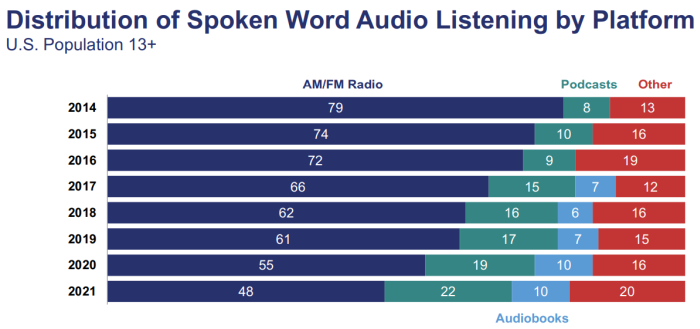
Podcast’s share of time with spoken word audio has increased by 176% over the last seven years; 16% in the last year.
There is much more to this important and revealing study. The presentation webinar included a good deal of qualitative research, mainly in the form of video interview clips where survey respondents talked about their listening choices. These clips, and the complete slide deck of study results, are freely available from Edison Research HERE.
.
